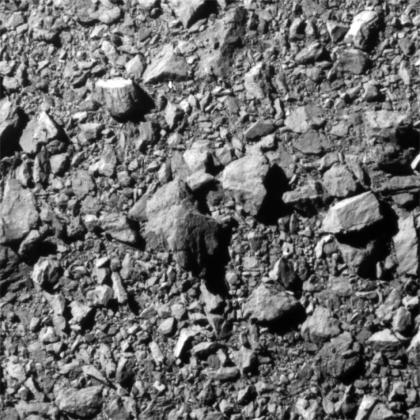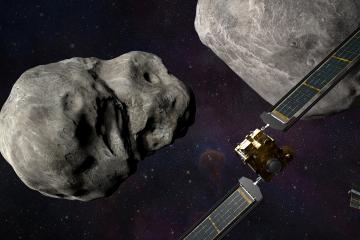After 10 months flying in space, NASA's Double Asteroid Redirection Test, or DART, the world's first planetary defense technology demonstration, successfully impacted its asteroid target on Monday—the agency's first attempt to move an asteroid in space.
Mission control at the Johns Hopkins Applied Physics Laboratory in Laurel, Maryland, announced the successful impact at 7:14 p.m. EDT.
As a part of NASA's overall planetary defense strategy, DART's impact with the asteroid Dimorphos demonstrates a viable mitigation technique for protecting the planet from an Earth-bound asteroid or comet, if one were discovered.

Image caption: The last complete image of asteroid moonlet Dimorphos, taken by the DRACO imager on NASA’s DART mission from approximately 7 miles from the asteroid and two seconds before impact. The image shows a patch of the asteroid that is 100 feet across.
Image credit: NASA / Johns Hopkins APL
"At its core, DART represents an unprecedented success for planetary defense, but it is also a mission of unity with a real benefit for all humanity," NASA Administrator Bill Nelson said. "As NASA studies the cosmos and our home planet, we're also working to protect that home, and this international collaboration turned science fiction into science fact, demonstrating one way to protect Earth."
DART targeted the asteroid moonlet Dimorphos, a small body just 530 feet (160 meters) in diameter. It orbits a larger, 2,560-foot (780-meter) asteroid called Didymos. Neither asteroid poses a threat to Earth.
The mission's one-way trip confirmed NASA can successfully navigate a spacecraft to intentionally collide with an asteroid to deflect it, a technique known as kinetic impact.
"This first-of-its-kind mission required incredible preparation and precision, and the team exceeded expectations on all counts," APL Director Ralph Semmel said. "Beyond the truly exciting success of the technology demonstration, capabilities based on DART could one day be used to change the course of an asteroid to protect our planet and preserve life on Earth as we know it."
Image caption: The final five-and-a-half minutes of images leading up to the DART spacecraft's intentional collision with asteroid Dimorphos. The DART spacecraft streamed these images from its DRACO camera back to Earth in real time as it approached the asteroid.
The investigation team will now observe Dimorphos using ground-based telescopes to confirm that DART's impact altered the asteroid's orbit around Didymos. Researchers expect the impact to shorten Dimorphos' orbit by about 1%, or roughly 10 minutes. Precisely measuring how much the asteroid was deflected is one of the primary purposes of the full-scale test.
The spacecraft's sole instrument, the Didymos Reconnaissance and Asteroid Camera for Optical navigation, or DRACO, together with a sophisticated guidance, navigation, and control system that works in tandem with Small-body Maneuvering Autonomous Real Time Navigation (SMART Nav) algorithms, enabled DART to identify and distinguish between the two asteroids, targeting the smaller body.
These systems guided the 1,260-pound box-shaped spacecraft through the final 56,000 miles of space into Dimorphos, intentionally crashing into it at roughly 14,000 miles per hour to slightly slow the asteroid's orbital speed. DRACO's final images, obtained by the spacecraft seconds before impact, revealed the surface of Dimorphos in close-up detail.
"What a remarkable day for humanity," said APL Space Exploration Sector Head Bobby Braun. "The team nailed it—and I couldn't be more proud of their efforts. Data from this test will inform future planetary defense efforts. Today is a milestone in demonstrating just how far our nation's space program has come, and how important it is to all of us here on Earth."
ATLAS observations of the DART spacecraft impact at Didymos! pic.twitter.com/26IKwB9VSo
— ATLAS Project (@fallingstarIfA) September 27, 2022
With the asteroid pair within 7 million miles of Earth, a global team is using dozens of telescopes stationed around the world and in space to observe the asteroid system. Over the coming weeks, they will characterize the ejecta produced and precisely measure Dimorphos' orbital change to determine how effectively DART deflected the asteroid. The results will help validate and improve scientific computer models critical to predicting the effectiveness of this technique as a reliable method for asteroid deflection.
Johns Hopkins APL manages the DART mission for NASA's Planetary Defense Coordination Office as a project of the agency's Planetary Missions Program Office.
Posted in Science+Technology
Tagged applied physics laboratory, double asteroid redirection test












